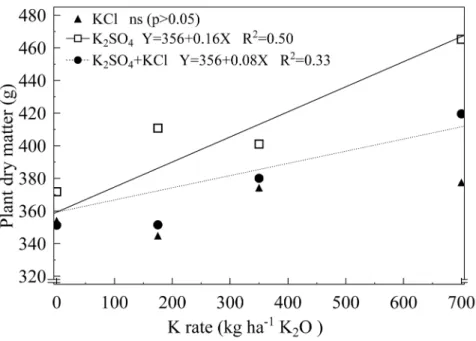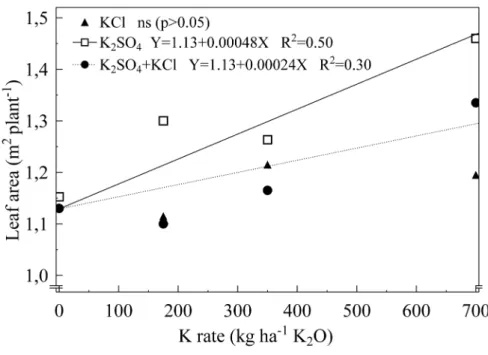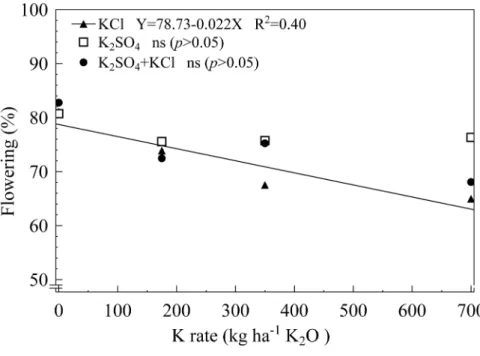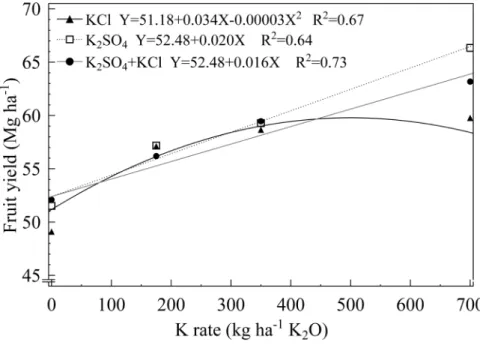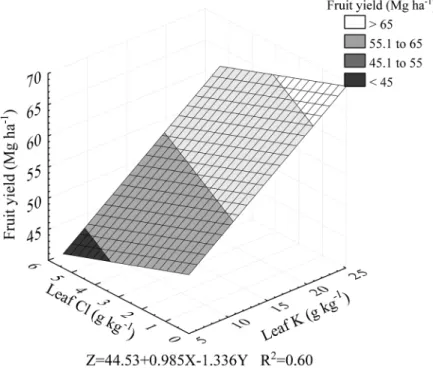1(Trabalho 151-10). Recebido em: 15-06-2010. Aceito para publicação em: 24-03-2011.
2Researcher. Centro de Solos e Recursos Ambientais do Instituto Agronômico (IAC). PO Box 28, 13012-970, Campinas- SP, Brazil.
E-mail: teixeira@iac.sp.gov.br
3Researcher. Centro de Solos e Recursos Ambientais do Instituto Agronômico (IAC). E-mail: quaggio@iac.sp.gov.br 4Researcher. Centro de Solos e Recursos Ambientais do Instituto Agronômico (IAC). E-mail: cantarella@iac.sp.gov.br 5Researcher. Centro de Solos e Recursos Ambientais do Instituto Agronômico (IAC). E-mail: evmellis@iac.sp.gov.br
POTASSIUM FERTILIZATION FOR PINEAPPLE:
EFFECTS ON PLANT GROWTH AND FRUIT YIELD
1LUIZ ANTONIO JUNQUEIRA TEIXEIRA2, JOSÉ ANTONIO QUAGGIO3,
HEITOR CANTARELLA4, ESTÊVÃO VICARI MELLIS
ABSTRACT – A field experiment with pineapple (Smooth Cayenne) was carried out on an Ultisol located in
the city of Agudos (22º30’S; 49º03’W), in the state of São Paulo, Brazil, with the objective of investigating the effects of rates and sources of potassium fertilizer on plant growth and fruit yield. The experiment was a complete factorial design (4x3) with four rates (0, 175, 350, and 700 kg ha-1 of K
2O) and three combinations
of K sources (100% KCl, 100% K2SO4, and 40% K2SO4 + 60% KCl). Plant growth and fruit yield were
evaluated. Biomass accumulation of pineapple plants was impaired by chlorine added with potassium chloride. Fruit yield increased with potassium fertilization. At high rates of K application, fertilization with K2SO4
showed better results than with KCl. Detrimental effects of KCl were associated with excess of chlorine.
Index terms: potassium chloride, potassium sulphate, Ananas comosus, K.
ADUBAÇÃO POTÁSSICA EM ABACAXIZEIRO: EFEITOS NO CRESCIMENTO
DAS PLANTAS E NA PRODUÇÃO DE FRUTOS
RESUMO – Foi realizado um experimento de campo com abacaxizeiro Smooth Cayenne num Argissolo
Vermelho-Amarelo localizado em Agudos-SP (22º30’S; 49º03’W), com o objetivo de determinar os efeitos de doses e fontes de potássio no crescimento e produção das plantas. O experimento foi estabelecido em blocos casualizados com os tratamentos dispostos em arranjo fatorial (4x3), com quatro doses (0; 175; 350 e 700 kg ha-1 of K
2O) e três combinações de fontes de K (100% KCl, 100% K2SO4 e 40% K2SO4 + 60% KCl).
Foram avaliados aspectos do crescimento e produção de frutos. A acumulação de biomassa pelas plantas foi prejudicada pelo cloreto fornecido com o uso de KCl. A produção de frutos aumentou em resposta à adubação potássica. Com as maiores doses de K, a aplicação de K2SO4 mostrou-se mais vantajosa do que a de KCl.
Os efeitos negativos do KCl foram associados ao excesso de cloreto para o abacaxizeiro.
Termos para indexação: cloreto de potássio / sulfato de potássio / Ananas comosus / K.
INTRODUCTION
Brazil is one of the world greatest growers of pineapple producing around 2.5 million tons in 2008 (FAO, 2010). Despite the importance of potassium fertilization for this crop, there is a lack of informa-tion about effects of different sources of K on fruit yield. According to results reported by Paula et al. (1991), Souza (1999a) and Spironello et al. (2004), fruit yield of pineapple is very responsive to potas-sium fertilization in Brazil.
The principal fertilizer compound contain-ing potassium used in Brazil is potassium chloride (KCl). Potassium sulphate (K2SO4) is also used but
it is restricted to some chlorine-sensitive crops, like tobacco and potato. In fruit crops, it is known that
the choice of K source has consequences on yield and quality of pineapples, kiwifruit, grape and citrus among other fruits (KLEINHENZ, 1999). Marchal et al. (1981) observed that pineapple fertilization with KCl decreased dry extract (a measure of sugar con-tent) and flesh color, increased acidity, and reduced fruit yield as compared to K2SO4. At the same time,
Cl- may cause leaf scorch in certain conditions. On
the other hand, chlorine increases fruit acidity and KCl may be recommended (1/4 to 1/3 of total rate) when fruits lack acidity (Py et al., 1984).
potas-plants ha-1. Selected slips of the ‘Smooth Cayenne’
variety previously treated with fungicides and pes-ticides were planted. Seven meters (approximately 35 plants) of central double row was sampled for evaluations.
Flower induction occurred spontaneously in about 65-85% of the plants. The remaining plants were artificially induced to flower with 3 L ha-1 of
Ethrel® (Etephon 21.7%) + urea (2%) in September
2004, approximately 15 months after planting. Pineapple plant growth evaluations, such as shoot plant and D-leaf mass and percentage of flow-ering (natural induction), were done in September 2004. Shoot plant dry matter was evaluated weighing five plants per plot. D-leaf measurements were done with 10 leaves. D-leaf S, K and Cl contents were analyzed according to Bataglia et al. (1983). Leaf area was assessed using the total leaf dry matter per plant and the weight of 70 leaf disks with known area. Fruits were harvested in January 2005, 19 months after pineapple was planted. Fruits were picked when bottom eyes turned from pale-green color to yellow. They were harvested by hand, break-ing off stalks of fruits. All fruits of central double line were harvested, counted and weighed.
The effects of treatments (sources and rates of K) were evaluated using analysis of variance (ANO-VA). When the effects of K sources were statistically significant (p<0.05 for the F test), differences among sources were compared with Tukey multiple range test (α=0.05). Regression equations were fit for the variables significantly affected by rates of K. Only models (equations) statistically significant (p<0.05) were presented. If the interaction between sources and rates was significant, the regressions for rates were done by sources.
In order to compare the profitability of K fertilization with different K sources, income increase due to K application was calculated. For this compari-son, the fruit price (FOB) was R$852.00 Mg-1, KCl cost
R$ 1442.00 Mg-1 and K
2SO4 cost R$ 2332.00 Mg-1
(average prices from 2004 to 2009). All these prices were collected in April, 2010, when $1USD=R$ 1.80.
RESULTS AND DISCUSSION
Plant growth
Biomass accumulation, leaf area and D-leaf mass of pineapple plants were significantly affected by sources of potassium (Table 1). A linear increment of plant mass was observed in response to K applica-tion as K2SO4 and K2SO4+KCl (Figure 1). With the application of 700 kg ha-1 of K
2O as KCl, shoot plant
sium source for pineapple in Brazil due to its lower price compared with K2SO4 (SOUZA, 1999a). Fur-thermore, Hepton (2003) stated that the better effects of K2SO4 are not universal, and considerable areas of pineapple fertilized with KCl with do not show any apparent adverse effect on either yield or fruit quality. To solve this issue in any particular growing area, Hepton (2003) recommended that comparative trials testing K sources should be established. So it is necessary to assess the effect of total or partial replacement of KCl by K2SO4 on yield and on some important characteristics of the pineapple fruit before more expensive K sources be recommended.
The objective of the present study was to evaluate the effects of rates and sources of potassium fertilizer on pineapple growth and fruit yield.
MATERIAL AND METHODS
The field was planted in June 2003, on a sandy and low fertility Ultisol located at the city of Agudos (22º30’S; 49º03’W), State of Sao Paulo, typical of this important pineapple production region in Brazil. The soil prior to set up of the experiment presented the following chemical characteristics: pH(CaCl2) 4.1;
organic matter 17 g dm-3; P
resin 6 mg dm-3;
exchange-able K, Ca, and Mg 0.7, 3.0, and 2.0 mmolc dm-3,
respectively, H+Al 38 mmolc dm-3 and soil base
saturation 13%.
The experiment was set up using a complete factorial design (4x3) with four rates (0; 175; 350, and 700 kg ha-1 of K
2O) and three combinations of
K sources (100% KCl; 100% K2SO4, and a
combi-nation of 40% K2SO4+60% KCl), with four blocks
(replications). In the combined treatment, 40% of K rates, as K2SO4, were split in the first two applications
and 60% of K rates were applied as KCl in the last two applications.
Phosphorus was applied 30 days after plant-ing (80 kg ha-1 of P
2O5 as single superphosphate-SSP).
Nitrogen (600 kg ha-1 of N), as ammonium nitrate
and potassium rates were split in four applications along pineapple cycle according to recommenda-tions of Spironello and Furlani. (1997). Fertilizers were surface applied, close to plant base, on an area of maximum root activity. Three months before planting, the soil was limed. Lime requirement was calculated to increase the soil base saturation to 50% of the CEC at pH 7.0 according to Spironello and Furlani (1997).
The plots were composed of three double rows (0.5 m by 1.15 m) 8 m long, summing up 39.6 m2. The plant spacing within the rows was
dry matter was increased 56 g in comparison with control treatment. For the same K rate, the treatment with K2SO4+KCl showed a positive variation of 112 g per plant. According to these data, K2SO4 seems to be more efficient than KCl to increase plant size. Those gains in dry matter accumulation is impor-tant because fruit weight is usually correlated with plant mass at pineapple flowering as indicated by Bartholomew et al. (2003) and Hepton (2003). Leaf area was affected by treatments in the same manner as plant mass (Figure 2).
It was observed that pineapple plant mass decreased linearly as Cl-leaf increased (Figure 3). No chlorine damage symptoms were found on the leaves, but K fertilization with KCl decreased bio-mass accumulation as compared to K2SO4 (Table 1). So, probably, the negative effects on plant growth of K fertilization using KCl may be related to the increase of chlorine availability on soil. These results corroborate to those reported by Lacoeuilhe (1978), Zehler et al. (1986) and Kleinhenz (1999).
The spontaneous flowering (Figure 4) was delayed by increasing K application as KCl, as demonstrated by the percentage of plants flowered on September 2004 (natural induction). The use of K2SO4 did not cause any significant delay on plant flowering. Delaying flowering frequently result in bigger pineapple plants and consequently, improved fruit size and quality. But in this case, postponement of flowering probably is due to detrimental effects of chlorine on plant development, as cited by Zehler et al. (1986).
In general, the use of K2SO4 as potassium source on pineapple nutritional program promoted superior results on pooled variables related to plant growth, compared with KCl. These effects are prob-ably associated with excess of chloride, which may reduce leaf size and plant growth rate as previously reported by Eaton (1973). Although K2SO4 is also a source of S, the correlation between S-leaf content and fruit yield was not significant (p>0.05). The effect of S carried by K2SO4 may be also diminished by the use of single superphosphate (11% S) as a source of P at planting.
Fruit yield
As pointed by Hepton (2003), it is necessary to have pineapple plants with satisfactory dry mat-ter accumulation before forcing in order to attain adequate fruit size for fresh market or canning. A significant relationship was observed between plant mass at forcing and fruit yield (Figure 5). So, the ef-fects of K fertilization on plant growth showed strong relation with fruit yield.
Fruit yield of pineapple plants showed
posi-tive responses to K fertilization. Fruit production increased linearly in response to potassium applied as K2SO4 or K2SO4+KCl, whereas for KCl, fruit yield changed in a quadratic manner as shown in Figure 6. Fruit yield was strongly correlated with the amount of K built up in D-leaf (D-leaf weight X K concentration) demonstrating the importance of potassium for pineapple nutrition and production (Figure 7). These results are in agreement with those reported by Paula et al. (1991), Souza (1999b) and Spironello et al. (2004) in Brazil.
The yield of fresh fruit without K fertilization was approximately 51.6 Mg ha-1. Maximum yield
(MY) of fresh fruit was 66.6 Mg -1 and 63.8 Mg -1
attained with application of 700 kg ha-1 of K 2Oas
K2SO4 and K2SO4+KCl, respectively. For KCl, the
maximum fruit yield of 60.9 Mg ha-1 was reached
with the rate of 525 kg ha-1 of K
2O (Figure 6). The
quadratic response of pineapple yield to rates of KCl may be associated to excess of chlorine mainly at the higher rates of K. Pineapple has been considered chlorine sensitive according to Teiwes and Grüne-berg (1963) and Kleinhez (1999). The relationship among the K leaf and the Cl leaf contents and fruit yield (Figure 8) also supports the positive effect of potassium and the detrimental effects of chlorine.
The relation between K fertilization and fruit yield (Figure 6) showed a reasonable agreement with fertilizer recommendations for pineapple crop in the State of São Paulo proposed by Spironello & Furlani (1997). For an expected yield higher than 50 Mg ha-1 and soil K lower than 0.15 mmol
c dm-3, it
is recommended to apply 600 kg ha-1 of K
2O. This
recommendation is between the rate to achieve maximum yield with KCl (525 kg ha-1 of K
2O) and
the rate of K2SO4 or KCl + K2SO4 (700 kg ha-1 of
K2O) that gave rise to maximum fruit yield. The yield increase due to the use of 700 kg ha-1 of K
2O as K2SO4, in comparison to
KCl was 5.7 Mg ha-1, equivalent to approximately
R$ 4 900.00 ha-1. It was sufficient to pay back the
higher cost of K2SO4 of R$ 2 086.00 ha-1 due to
ap-plication of 700 kg ha-1 of K
2O as K2SO4 instead of
491 kg ha-1 of K
2O as KCl (Table 2). The higher cost
of K2SO4 was balanced by the increase of fertilizer efficiency especially for the highest rate of applica-tion. Fertilizer efficiency for K2SO4 was around 2 000 kg ha-1 of fruits per each 100 kg ha-1 of K
2O,
slightly higher than for K2SO4+KCL, while fertilizer efficiency for the rate of 700 kg ha-1 ofK
2O as KCl
was approximately 1 400 kg ha-1 of fruits per each
100 kg ha-1 of K
2O. In terms of net profit due to K
TABLE 1 - Means of plant mass, leaf area, D-leaf mass and flowering for potassium sources, 15 months after pineapple planting.
Source of K Plant mass1 Leaf area2 D-leaf mass1 Flowering
g m2 g %
KCl 362 b3 1.16 b 7.4 ab 72 a
K2SO4 413 a 1.30 a 7.8 a 77 a K2SO4+KCl 376 ab 1.18 ab 7.2 b 75 a
1 Dry matter mass of one plant. 2 Leaf area of one plant. 3 Within columns, values followed by the same letter indicate that K sources
are not significantly different according to Tukey’s test (p<0.05).
TABLE 2 - Economic analysis of pineapple K fertilization for the experiment conditions.
Source1 Rate2 Yield3 Gross
income4 fertilizationCost of K 5 Yield increase6increaseIncome 7 Net profit of K fertilization8
kg ha-1 K
2O Mg ha-1 --- R$ ha-1 --- Mg ha-1 --- R$ ha-1
--- 0 51.6 44 019 0 0 0 0
K2SO4 700(MY) 66.6 56 736 3 265 14.9 12 717 9 452
KCl+K2SO4 700(MY) 63.8 54 395 2 315 12.2 10 376 8 061
KCl 525(MY) 60.9 51 878 1 261 9.2 7 859 6 598 KCl 491(MPY) 60.8 51 837 1 179 9.2 7 818 6 639
1 KCl+K
2SO4: 60% KCl + 40% K2SO4. 2 MY: maximum yield – K rate to reach highest possible yield; MPY: maximum profit yield
- K rate to get the highest net return with fertilization. 3 Yield per ha (pineapple fruit+crown). 4 Yield X fruit price (FOB) (R$ 852.00
Mg-1 – average price 2004 to 2009). 5 KCl=R$ 1442.00 Mg-1; K
2SO4=R$ 2332.00 Mg-1 (average price 2004 to 2009); 6 Yield increase
compared to control treatment without K. 7 Gross income increase compared to control treatment. 8 Gross income increases due to K
use minus cost of K fertilization. Prices collected in April, 2010, when $1USD=R$ 1.80.
FIGURE 1 - Dry matter mass of pineapple plants influenced by rates and sources of potassium. Sampling
FIGURE 2 - Leaf area of pineapple plants influenced by rates and sources of potassium. Sampling in September, 2004.
FIGURE 3 - Dry matter mass of pineapple plants as a function of “D” leaf Cl content at the rate of 700
kg ha-1 K
FIGURE 4 - Pineapple spontaneous flowering as influenced by rates and sources of potassium. Sampling in September 2004.
FIGURE 6- Fruit yield as influenced by rates and sources of potassium. Sampling in January 2005, 19 months after pineapple was planted.
FIGURE 8 - Relationship between fruit yield of pineapple plants (Z), leaf K (X) and leaf Cl (Y) contents.
CONCLUSIONS
1-Pineapple plants showed a positive yield response to K applications. At high rates of K application, fertilization of pineapple with K2SO4
showed better results than with KCl. Detrimental effects of KCl were associated with the excess of chlorine.
2-The profit of fertilization of pineapple with K2SO4 (exclusively or combined with KCl)
was higher than using only KCl as K source at the experiment conditions.
ACKNOWLEDGEMENTS
The authors are grateful to Milton and Armando Yoshiura, pineapple growers, for their support for field activities and to Sulphate of Potash Information Board (SOPIB) and to Fundação de Apoio à Pesquisa Agrícola (FUNDAG), for financial support.
REFERENCES
BARTHOLOMEW, D.P.; MALÉZIEUX, E.; SANEWSKI, G.M.; SINCLAIR, E. Inflorescence and fruit development and yield. In: BARTHOLOMEW, D.P.; PAULL, R.E.; ROHRBACH, K.G. (Ed.).
Pineapple: botany, production and uses. Wallingford:
CABI Publishing, 2003. p.167-202.
BATAGLIA, O.C.; FURLANI, A.M.C.; TEIXEIRA, J.P.F.; FURLANI, P.R.; GALLO, J.R. Métodos de
análise química de plantas. Campinas: IAC, 1983.
48p. (Boletim Técnico, 78)
EATON, F.M. Chlorine. In: CHAPMAN, H.D. (Ed.).
Diagnostic criteria for plants and soils. Riverside:
Dept. of Soils and Plant Nutrition/University of California, 1973. p.98-135.
FAO. FAOSTAT. Disponível em: < http://faostat. fao.org>. Acesso em: 20 abr. 2010.
HEPTON, A. Cultural system. In: BARTHOLOMEW, D.P.; PAULL, R.E.; ROHRBACH, K.G. (Ed.).
Pineapple: botany, production and uses. Wallingford:
KLEINHENZ, V. Sulfur and chloride in the
soil-plant system.Kassel: K+S Group, 1999. 99p.
LACOEUILHE, J.J. La fumure N-K de l’ananas em Côte d’Ivoire. Fruits, Paris, v.33, n.5, p.341-348, 1978.
MARCHAL, J. ;PINON, A.; TEISSON, C. Effets de la forme d’engrais potassiques sur la qualité de l’ananas en Côte d’Ivoire. Fruits, Paris, v.36, n.12, p.737-743, 1981.
PAULA, M.B.; CARVALHO, V.D.; NOGUEIRA, F.D.; SOUZA, L.F. Efeito da calagem, potássio e nitrogênio na produção e qualidade do fruto do abacaxizeiro. Pesquisa Agropecuária Brasileira, Brasília, v.26, n.9, p.1337-1343, 1991.
PY, C.; LACOEUILHE, J.J.; TEISSON, C.
L’Ananas. Paris: G.P. Maisonneuve et Larose et
ACCT, 1984. 562p.
SAMUELS, G.; GANDÍA, H. Effects of potassium chloride and sulfate on pineapple yields and quality.
The Journal of Agriculture of the University of
Puerto Rico, Rio Piedras, v.44, n.1, p.16-20, 1960.
SOUZA, L.F.S. Correção de acidez e adubação. In: CUNHA, G.A.P.; CABRAL, J.R.S.; SOUZA, L.F.S. (Ed.). O abacaxizeiro: cultivo, agroindústria
e economia. Brasília: EMBRAPA, 1999a. p.169-202.
SOUZA, L.F.S. Exigência edáficas e nutricionais. In: CUNHA, G.A.P.; CABRAL, J.R.S.; SOUZA, L.F.S. (Ed.). O abacaxizeiro: cultivo, agroindústria e economia. Brasília: EMBRAPA, 1999b. p.67-82.
SPIRONELLO, A.; FURLANI, P.R. Abacaxi. In: RAIJ, B. van; CANTARELLA, H.; QUAGGIO, J.A.; FURLANI, A.M.C. (Ed.). Recomendações de adubação e calagem para o Estado de São
Paulo. 2.ed. Campinas: IAC, 1997. p.128. (Boletim
Técnico, 100)
SPIRONELLO, A.; QUAGGIO, J.A.; TEIXEIRA, L.A.J.; FURLANI, P.R.; SIGRIST, J.M.M. Pineapple yield and fruit quality effected by NPK fertilization in a tropical soil. Revista Barasileira de Fruticultura,
Jaboticabal, v.26, n.1, p.155-159, 2004.
TEIWES, G.; GRÜNEBERG, F. Conocimientos y experiencias en la fertilización de la piña. Boletín
Verde, Hannover, v.3, p.1-67, 1963.
ZEHLER, E.; KREIPE, H.; GETHING, P.A. Sulfato
de potássio e cloreto de potássio: sua influência
